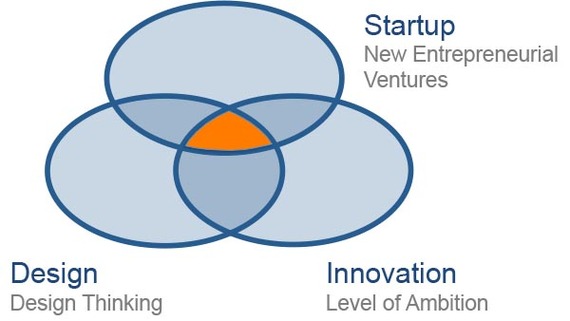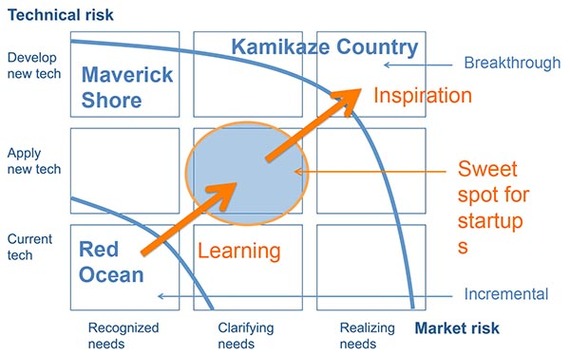To compete in an increasingly volatile Creative Economy, business has to create new design driven high-impact ventures that focus on breakthrough innovation. The organizational structures, procedures and product development for startups stand in stark contrast to that of an established business, thus learning becomes imperative. So, how do these ventures manage to outpace competition by learning quickly and yet still avoid running out of steam?
In order for design driven high-impact startups to learn faster, better and cheaper than ever before they must build their dynamic capabilities and those capabilities strongly depend on the organization's level of innovativeness.
Applying the Market - Technology Risk matrix can assist in clarifying where a business opportunity is located and what risk and learning is associated with its development. Stanford studies of startup teams have shown that an area of medium market and medium technology risk is the sweet spot for startups. However, to accomplish this, teams need inspiration from breakthrough innovation to move them away from their comfortable position in current reality. The ability to converge inspiration and current reality is the sweet spot where the most accelerated learning resides.
Building dynamic capabilities on multiple levels is necessary to achieve this, involving leadership, management end experts. Engaged in a step-by-step process, overall success depends on the performance of the weakest link and after selecting a strong market - technology position, the weakest link becomes implementation.
Applying the Bridging Business & Design model will collaboratively assist leaders, managers and experts to connect organizational capabilities with business model experimentation. This is accomplished through leaders examining the strategic 'Why?' followed by management, addressing the 'How?' and applying their strengths to connect the business model with design briefing. Finally, functional experts create the 'What?' and, with their hands-on experience, they link the design brief with iterative implementation.
By nature, leaders' competencies make them ideally suited for developing 'Why?' the managers are best suited for the 'How?' and the functional experts for the 'What'? These are exactly the respective areas that they need to own and within which to build their dynamic capabilities.
What the three groups need to learn is strikingly similar in nature and depends squarely on the organization's level of ambition when it comes to innovation. The handling capability of the 'Why', 'How' and 'What', have three fundamentally different natures.
Breakthrough innovation requires leaders, managers and experts alike, to have descriptive capabilities. Intermediate innovation calls for prescriptive abilities and incremental innovation demands predictive capabilities. Leaders, managers and experts with capabilities in, for example, predictive capabilities, will need to build skills in formulating prescription models, processes and tools to engage in intermediary innovation. To move to breakthrough innovation, the professional will need to build first in prescriptive before moving on to descriptive.
So where in the organization does one begin when establishing the innovation ambition and required capability building? We propose one begin from the bottom up for three main reasons.
Frontline experts are exposed to current reality, which is what will inspire action. Secondly, experts are customarily T-, TT- or TTT- shaped people, making them ideal for identifying links between disparate domains, a requirement for providing inspirational breakthrough innovation targets. Thirdly, there are many more front line experts than leaders or managers, increasing the probability that an attractive inspiration will be identified.
When an inspirational innovation has been identified, it needs to be communicated to the organization's leaders who will then allocate resources and directly support the new entrepreneurial ventures. For experts, the question now becomes which Design Quality Criteria to focus on first?
Accelerating the learning curve is a huge challenge and the organization that can manage this, by aligning entrepreneurship, innovation and design, is in an excellent position to create and own a new niche market. However, if this challenge is not met successfully, they may find themselves once again swimming with the sharks in the Red Ocean.



